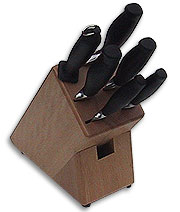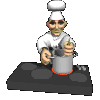| The
Phantom Chef Culinary Advice You Can Really Use Chef Smorgas of Borg |
|||
|
The Phantom Chef |
Getting the edge: Knives Knives are the most useful tools of any used in
the culinary arts. Their uses are legion. The knife slices! Dices!
Chops! Minces! And makes wonderful Julienne fries! But wait! There's
more!
|
||
|
How Many Knives Do I Need? The most used knife you will own will be a French knife,
also called a chef's knife. Whatever blade length feels best to
you is what is most important.Men tend to feel most comfortable
using one with a 12-inch blade. Another recommended knife is one with a 6 inch or 8 inch long,
flexible blade. This is sometimes called a boning knife.
Select one with a blade about one inch wide at the handle. This
knife is very useful for jobs such as deboning chicken pieces. A good carving knife makes a nice addition
to your knife kit as well. Select one with about a 2-inch wide blade
and is 10 to 12 inches long. The carving knife will have a wavy,
serrated-style edge. A carving blade is noted by the deep and long
channels above each serration. This makes carving easier by channeling
juices away from the blade. A serrated knife with a 4 inch or 6 inch long blade is necessary
for soft fruits and vegetables that are soft inside. This is sometimes
called a 'tomato knife'. A good paring knife comes in handy for many small jobs, such as peeling fruit. Select one with a blade length with which you are comfortable. Usually, these knives have a 3 or 4-inch blade. And lastly, a serrated edged bread knife with at least a 10-inch long
blade for, well, slicing bread. Knife Materials The two main knife-manufacturing types are forged and stamped. Forged knives are notable for the wide 'hilt' near the handle. This gives the knife 'heft' for heavy-duty cutting jobs. These knives are forged individually and are the best type for use when the knife will be making a lot of contact with a cutting board. Stamped knives are stamped (cut) from a single sheet of metal. Stamped knives are best suited for light work without a lot of contact with a cutting board. The best material for knife blades is high-carbon stainless steel. They are easy to keep clean and sharpen easily. To be avoided are knives made of regular steel (they rust and require being oiled before storage) and those of 'surgical' stainless steel. Surgical stainless is the sharpest edge possible. But unless you own an industrial laser, they are nearly impossible to sharpen. As for ceramic knives, I must admit that I've never used one. Therefore, I can offer no meaningful opinion on them at this time. Always look for knives that are 'full tang'. The tang is the part of the knife that is inserted into the handle. Purchase only knives that have a tang that goes the full length of the handle. Usually, the tang is visible in high-quality knives with the handle elements attached to each side with brass rivets. Cutting Boards Cutting surfaces are best when they 'give' to the pressure of the knife. They should also have a smooth surface that is easy to clean. The best for use are those made of polyethylene or wood. Avoid cutting boards made of china, porcelain, tile, Formica or, heaven forbid, steel. Always clean the cutting board immediately after use to prevent cross-contamination of foods. Care of Knives There is no such thing as truly 'stainless' steel. Avoid allowing acidic foods (lemon, prepared mustard, etc) to remain on the blade for long after use. Rinse immediately after cutting such foods. Should your 'stainless' blade become tarnished, use a non-abrasive metal polish for cleaning. ("Stainless steel cleaners" are sold almost everywhere.) NEVER put knives in a dishwasher! The high heat, especially in the drying cycle, as well as the detergents can damage all types of handles. Wood handles are most susceptible to damage. Also, the high-pressure wash can cause the blade edges of the knives to bang against other metal objects in the washer, chipping and permanently damaging the cutting edge. (Safety Note: Placing knives in an automatic dishwasher can lead to serious cuts to yourself while removing items from it) It is recommended that knives be washed individually in soapy water, rinsed and wiped dry before storage. Food Safety Note: It is required in commercial/institutional settings that knives be washed, rinsed and dipped in a sanitizer solution (one tablespoonful of chlorine bleach in one gallon of water) and allowed to air dry. If you can, this is the safest method recommended for the home kitchen. Except when using a cleaver, NEVER attempt to cut through bone with a knife. NEVER use a sharp knife for poking, prying, separating or cutting into frozen foods. NEVERuse a sharp knife as a screwdriver or as a can opener. (Come on. You know you've done that.) This can result in the breaking or bending of the knife-edge or tip. (Buyer's note: Knife manufacturers do not cover damage from 'abuse' such as mentioned) Storing of Your Prized Knives
If space is at a premium, there are knife blocks designed for mounting directly underneath a counter. An in-drawer wooden knife tray is also a good option. You should never store knives loosely in drawers. If there is no room for a knife tray, invest in plastic sheathes to protect your prized knives from damage, as well as yourself from injury. Sharpening The most dangerous tool in the kitchen is a dull knife. Wait. Shouldn't that read "…a sharp knife?" Actually, no. A dull knife forces you to push down harder to force it through what you are cutting. This increases the likelihood that the knife will slip and cause injury. A good quality sharpening steel is a must for keeping knives sharp. The steel must be harder than the steel in the blade of the knife. A Rockwell hardness of at least 62 degrees is recommended. The steel must have magnetic qualities as well to capture small, metallic particles removed from the knife-edge. The safest way to use sharpening steel is to hold it by the handle with the point down on a table or cutting board. Hold the blade at a 20-degree angle to the steel. Starting at the heel of the blade, move downward while pulling the blade towards you in slight arc. Repeat on the other side of the blade. 20 times per side should be plenty. Speed is not important. The most important thing is to maintain the angle and sharpen the full length of the blade. Serrated edge knives should only be sharpened by a professional. Stones should not be used unless the knife is extremely dull. I do not care to use a stone myself. When my knives become resistant to sharpening with a steel, I take them to a professional cutlery store for sharpening. Have fun cutting up in the kitchen! Next: Basic cutting techniques Keep on cooking! Smorgas
(All rights reserved by the author)
Comments, questions and suggestions welcome.
E-Mail to Smorgas_of_Borg, the Phantom Chef |
|||
| Previous Columns | ||
| 1 | Matchbox
Kitchens Sept 2002 |
|
| 2 |
Recipe
Conversions |
|
[an error occurred while processing this directive]



